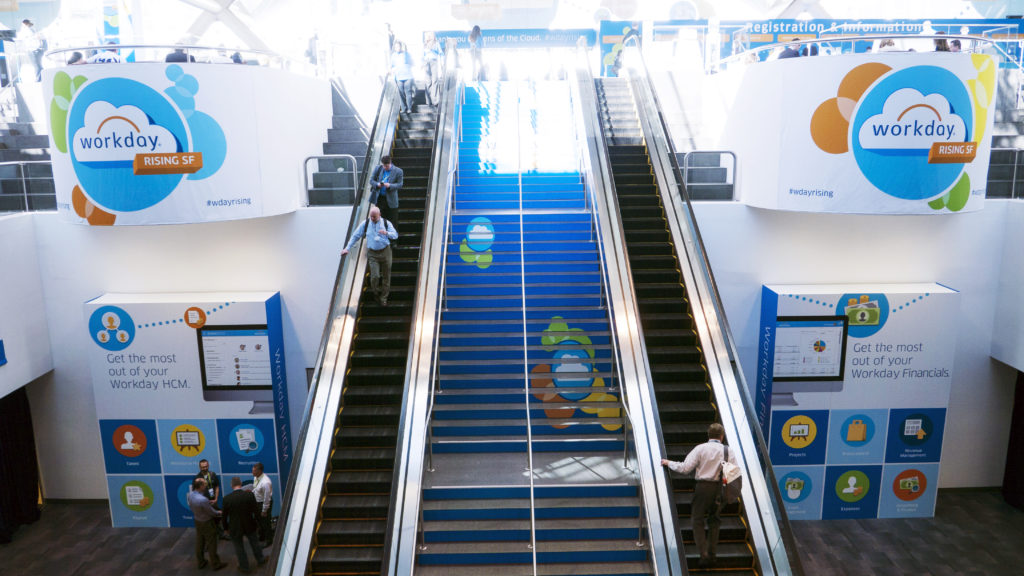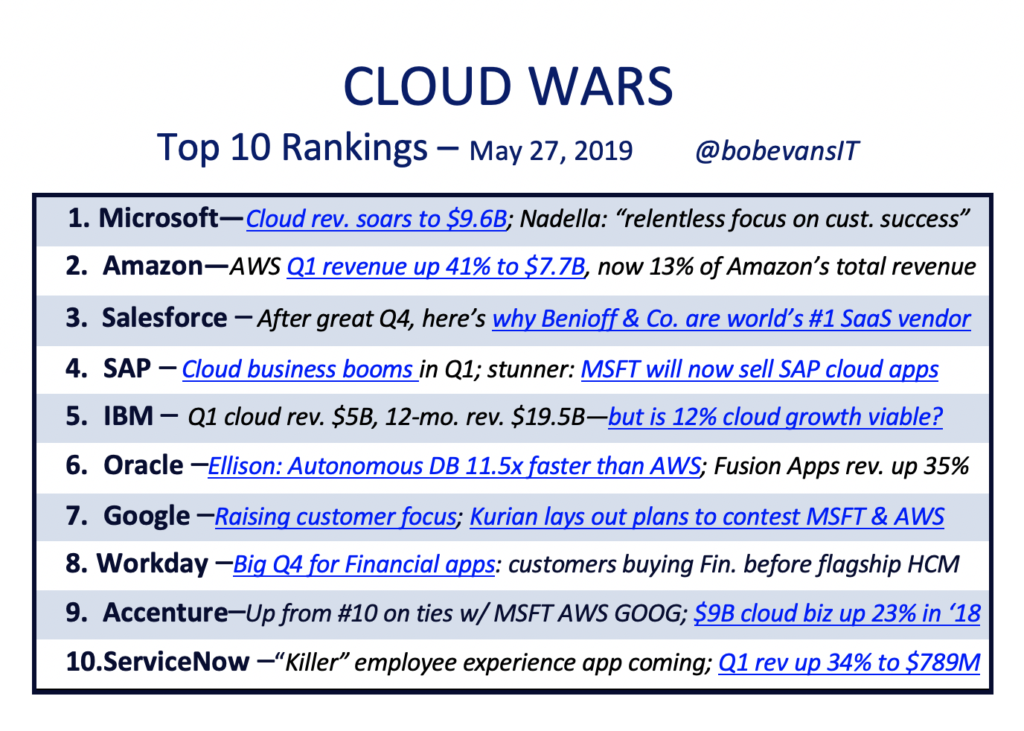It’s extremely likely that within the coming year, Workday will report its first billion-dollar quarter.
“Plucky little Workday”—what a myth!!
Through its long-time focus on customer success, judicious acquisitions, rigorous deployment of modern technology and bold but steady leadership, Workday has become one of the most successful and fast-growing enterprise software companies in the world. (See Workday Cranks Up the Heat on Oracle and SAP in Cloud ERP Wars).
And soon it will be generating quarterly revenue of a billion dollars or more.
In its fiscal Q1 ended April 30, Workday reported total revenue of $825 million, up 33%. Its fairly new Prism Analytics business was up 70%. The annual contract value for its Financials applications were up 50%. And its flagship HCM products continue to find fast-growing acceptance among the world’s largest corporations.
So what’s the secret behind the Workday growth engine? How does it rack up steep growth rates quarter after quarter even as customer-satisfaction scores and renewal rates remain impressively high?
Clearly, the points I raised above about customer focus, advanced technology and excellent leadership are core factors. But let’s hear it directly from Workday’s leadership, and particularly co-founder and CEO Aneel Bhusri, as stated in the company’s earnings call earlier this week.
From that call, here are 10 key insights into why Workday’s surging toward its first billion-dollar quarter.
1. Customer Focus.
At the very opening of his prepared remarks, Bhusri said this: “We continue to attract new customers and many of our current customers are growing their investments with us. Our customer satisfaction rating remains amongst the highest in enterprise software and the success of our customers is a cornerstone of our long term business strategy.” Easy to say, but clearly not so easy to do. Workday was the first company in the Cloud Wars Top 10 to hammer relentlessly on the theme of customer success. Since then, every other top cloud vendor has begun emulating that approach. (See Workday Reveals Secret Weapon Against Oracle and SAP).
2. The Huge Success of the Adaptive Insights Acquisition.
Exactly one year ago, Workday acquired planning specialist Adaptive Insights for $1.55 billion, a deal that’s begun to look like a fabulous bargain. From Bhusri’s opening remarks: “Q1 was our third quarter with the Adaptive Insights Business Planning Cloud and customer demand continues to reinforce our confidence in the long-term opportunity. We added 150 standalone Adaptive deals and had great success selling to large enterprises, with approximately 50 deals representing both platform sales and Planning add-ons.”
3. Aggressive Deployment of Advanced Technology.
Bhusri has ensured that Workday remains a pioneer in deploying machine learning across all of its products to continue to offer differentiation from its much larger competitors. (This is spelled out in more detail in yesterday’s column, Why High-Flying Workday Is Pushing ML over M&A.)
4. Workday’s Flagship HCM Products Are Now Mainstream—And Getting Help.
“The HR product line continues to do very well. We’re now mainstream in terms of the types of customers that are looking to move to the cloud,” Bhusri said. “And with the high levels of customer satisfaction and the proven points of customers being live, all of that bodes well for Workday. And one thing I’d say about this quarter is that all the product lines are beginning to kick in and take some of the pressure off HCM. I hope that continues.”
5. Fortune 500 Appetite for Cloud Financials Is Increasing.
Asked about uptake for Financials apps among large corporations, Bhusri said, “We’re seeing a very similar adoption pattern for the Fortune 500 as we did with HR five or six years ago. The more reference customers we have, and the more that customers are facing painful upgrades of their legacy systems, and the more regulations change with things like 606, those are all catalysts for us. And, the cloud is now viewed as the preferred deployment option versus on-premises. That’s true even for CFOs for both planning and core accounting. That’s been the case in HR and CRM for a while, and it’s definitely beginning to happen in finance now as well.”
6. An Expanding and Integrated Suite of Products.
Building off his earlier point about how Workday’s broader product line is taking some of the pressure off of the HCM flagship, Bhusri endorsed the suite concept. He said, “I think it’s still early, but if a customer has Workday HR and Planning—more than just one Workday product in the account—then I think it bodes well for our Financials. Because then the account has the chances to default to a Workday platform.”
Later in the Q&A, Bhusri gave a classic hedged answer when asked about the possibility of a further expansion of the product line into the supply-chain space: “I would say it’s on the radar but I wouldn’t say that we are going to be announcing anything imminently. That’s a big undertaking, and we still have more work to do to really establish ourselves as leaders outside of HR. We want that same leadership position for Financials and for Planning…
“With Prism Analytics, we saw 70% growth this past quarter, so I don’t feel the need for another growth engine at this point. And frankly, I think it would be a distraction. We have a lot of work to do on the product side, especially as we take all the products into the world of machine learning. But you know, I would ask that question every year. And sometime you might get a different answer.” (Emphasis added.)
7. A Big Competitive Win at Legg Mason.
“We won Legg Mason for the full organization. I’m not going into all the competitive dynamics except to say they were happy with what they rolled out initially and so they decided to broaden their use of Workday. And that’s probably best to leave it there.
“There are failed cloud implementations and sometimes there are cloud implementations of best-of-breed products tied back to legacy on-premises core HR and finance systems. And all of those situations create opportunities for us because it all comes back to having happy customers and to having projects that are successful. So as we stay focused on that and [some companies] don’t have successful outcomes, we hope they’ll look to Workday.”
8. Migrating Workday Planning Customers to Adaptive Insights Business Planning Cloud.
From Tom Bogan, founder and CEO of Adaptive Insights: “We have made excellent progress and we’ve had conversations with probably 75% of the customers. For some of the customers who had implemented the Workday planning product, it’s operating successfully for them, so they’ll be a little bit slower in their migration. But we’ve already successfully migrated several customers.”
9. Strong and Growing Acceptance of Workday Financials.
From president of field operations Chano Fernandez: “The momentum continues in terms of seeing Financials moving more up-market and there is a good strength there. We had a great quarter in terms of large Financials customers, particularly in healthcare and financial services.
“We still have good to momentum continuing in terms of Financials ‘first mover’ [where customers buy Workday Financials before having bought Workday HCM] that we highlighted in Q4, and also some good progress with HCM customers being very happy with the product and the partnership and so considering us for Financials. And the pipeline around those opportunities seems pretty healthy going forward.”
10. Avoiding Additional Acquisitions.
Asked about more M&A activity, Bhusri said, “My personal view is that larger acquisitions are really, really difficult. And frankly, we had a lot of things fell in place with Adaptive: for one, we knew the team really well as [Adaptive Insights founder and CEO Tom Bogan] Tom and I are close friends going back 15 years. And, we had very similar corporate cultures, with a very similar focus on customers. Then the products and technology were very complementary. Plus, we knew the space—and we knew we were pretty far behind where Adaptive was.
“I just don’t think there’s a lot more targets out there like that,” he added, noting that any potential “big ones will have to pass through a very tight filter on cultural fit, on technology compatibility, on limited overlap in terms of both revenue and technology.”
Subscribe to the Cloud Wars Newsletter for in-depth analysis of the major cloud vendors from the perspective of business customers. It’s free, it’s exclusive, and it’s great!









